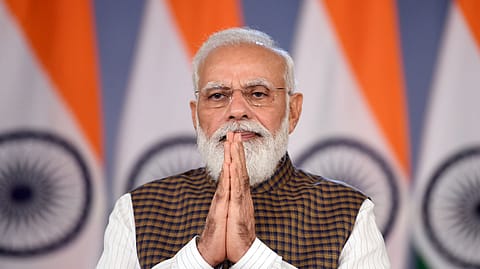India Energy Week 2025: PM Modi says 21st century belongs to India, highlights energy ambitions
India Energy Week 2025 commenced on Tuesday at Yashobhoomi, Dwarka, Delhi, bringing together global industry leaders to discuss the future of energy.

“Every expert of the world is saying that the 21st century belongs to India. India is not only driving its own growth but also driving the world's growth, and our energy sector plays a very big role in this,” Prime Minister Narendra Modi said while outlining India's ambitious renewable energy goals for the next decade.
India Energy Week 2025 commenced on Tuesday at Yashobhoomi, Dwarka, Delhi, bringing together global industry leaders to discuss the future of energy. The Prime Minister inaugurated the event virtually from France.
“In the last 10 years, we have increased our solar energy generation capacity thirty-two times. Today India is the third largest solar power generating nation in the world. Our non-fossil fuel energy capacity has increased three times. India is the first country among G-20 nations to meet the goals of the Paris Agreement,” Modi said in his address.
Modi also highlighted India’s target to add 500 gigawatts (GW) of renewable energy capacity by 2030 and achieve net-zero carbon emissions for Indian Railways by the same year. He reaffirmed that the next two decades are crucial for India's vision of becoming a developed nation by 2047.
Modi also urged investors to explore India's expanding energy sector, particularly in renewable energy and hydrocarbons. "There are possibilities of new investments, and I hope that you explore all possibilities in India," he said, referring to the country's 500 GW renewable energy target, five million metric tonnes of green hydrogen production by 2030, and the launch of new bidding rounds for oil and gas assets.
“Our targets may look very ambitious; however, whatever India has achieved in the last 10 years gives us the confidence that we will achieve these targets too,” he added.
India’s renewable energy push includes a five-million metric tonne annual target for green hydrogen production. The country has also achieved a 19% ethanol blending rate, with a goal of reaching 20% by October 2025. Modi noted that this shift has contributed to foreign exchange savings and CO2 emission reductions, with the biofuels sector set for rapid expansion.
Recommended Stories
Hydrocarbon exploration and refining capacity were also key topics. Modi emphasised India’s position as the fourth-largest refining hub and the government's plan to expand refining capacity by 20%. Additionally, with rising electric vehicle (EV) demand, India is developing its battery and storage infrastructure. Budget measures supporting green energy innovation include customs duty exemptions for key minerals like lithium-ion battery waste, cobalt powder, and lead, alongside a push for a non-lithium battery ecosystem under the National Critical Minerals Mission.
He outlined five key pillars of India’s energy ambitions: resource harnessing, fostering innovation, economic strength with political stability, strategic geography, and a commitment to global sustainability.
Union Minister for Petroleum and Natural Gas, Hardeep Singh Puri, also addressed the gathering, stressing the continued relevance of traditional energy sources. “Even when renewables become the dominant energy sources, oil and gas will continue to play a pivotal role—not just in power generation but in stabilising grids, industrial hydrogen, and energy storage innovations,” Puri said.